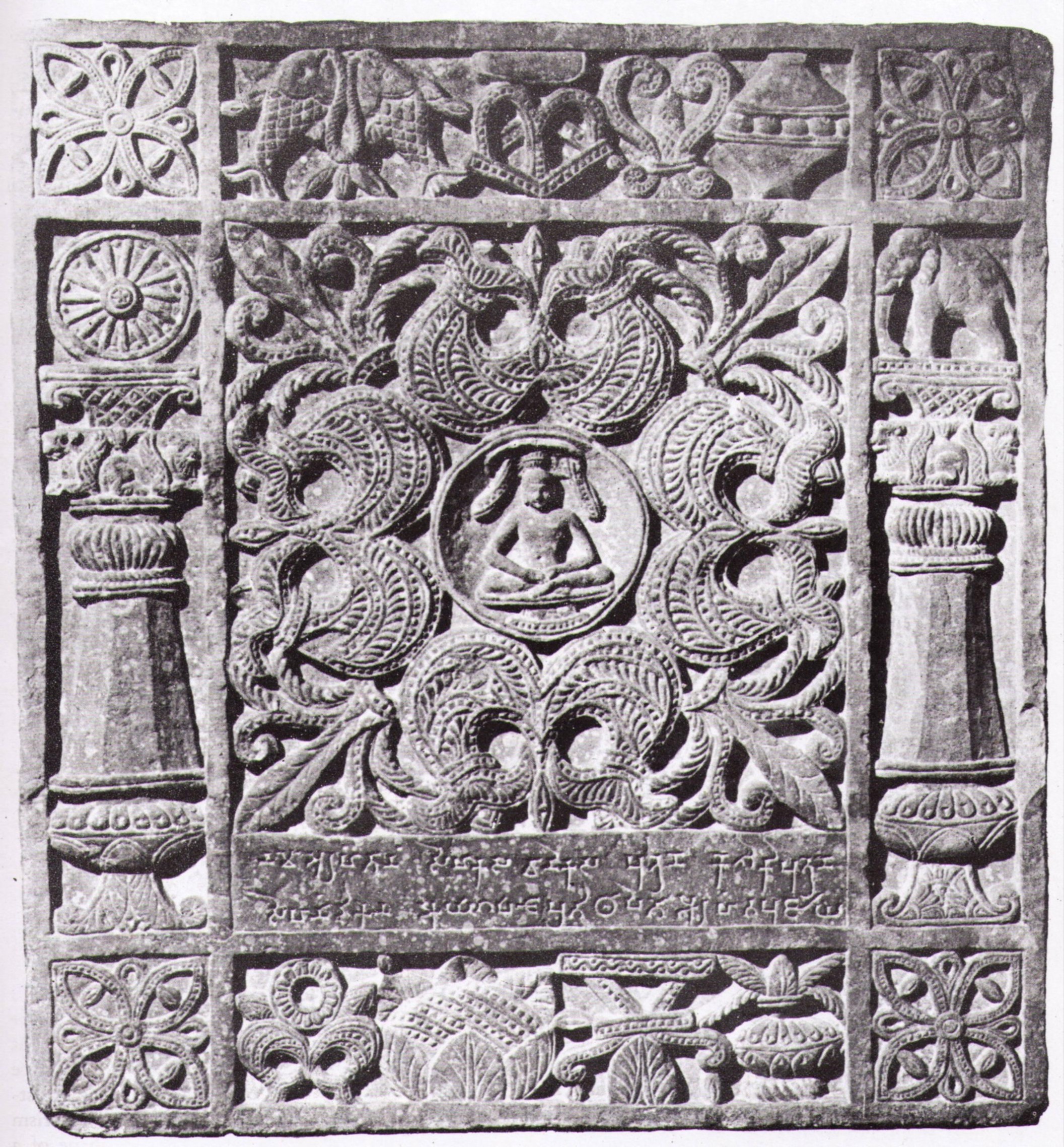Jain Archaeological Evidences of post-Sunga Period have been found in several places of Northern India. These range from inscriptions, temples and idols of various Jains of this period.
Jain Archaeological Evidences of Post Sunga Period have been found scattered all over Northern India. Inscriptions and statues of various Jains of this period (B.C. 188 to A.D. 319) have been excavated from different places. According to these findings, one gets an idea of its wide prevalence and popularity of Jainism during this time. Several inscriptions of the periods of Kanishka, Huviska, Vasudeo and others have also come to light. These illustrate that the Jain community continued to flourish during the time of Kushana Empire. The images of Jain Tirthankaras of the Kushana age may be divided into three categories:
- In which the Jain figures form a part of a sculptural panel
- In which the figures are represented as images for worship and
- Figures in the middle of the ayagapatas.

ayagapata
At this time, the Yakshas and Yakshanis also gained importance along with the Tirthankaras and their images were also installed around the images of Jain Tirthankaras. The individual identity of the image was not marked with any special emblem. This style developed much later. At this time the style of constructing panels with stories from the life of the Tirthankaras developed. The earliest inscription of Kushana period is found at Mathura and falls within the reign of Kaniska. Inscriptions of Kaniska and Huviska were found in the eastern adjoining parts of India at Mathura and Pabhosa. These reflect that Jain monks lived at those places from the pre-Christian era and benefited from the royal patronage. In the first of the 4th century A.D. the Jain canon was also collected and edited here under the leadership of Skandila. This particular region of Bihar has bestowed upon images of stone and metal and as well as few terracotta figurines of the period. The stone images come mainly from Rajgriha while Chausa in Bhojpur District has given sixteen metal images of which six of them belong to the Post Sunga Period.
Rajgriha
Rajgriha is a city and a notified area in Nalanda district in the Indian state of Bihar. It is the ancient capital of Magadha of Bihar that has several remarkable ruins. One of the early Jain caves of this period is the Sona Bhandar cave. It bears a Brahmi script or inscription of first century A.D. According to it Muni Vairadeva excavated the two caves to be used by the Jain ascetics. Many Jain images of were installed in them. An ancient Jain stambha having a Jain statue is still preserved here. Many references have also been made in the inscriptions about the second cave. In the Digambara tradition, the name of Varajesh has been quite popular and he is regarded as the last of the Prajasramans.
Chausa
Chausa is a block of Buxar district in Patna division of Bihar. Many Jain bronze images belonging to this period have been discovered from Chausa. These reflect the popularity of Jain religion in the South Bihar region. Seven nude figures of the Jain Tirthankaras have been found. They are all represented standing and are in the kayotsarga posture. Though the images are small in size, they exhibit the basic characteristics of the Kushana art. These images bear resemblances to Mathura sculptures in their style and execution. The treatment of the hair style is also similar to the Mathura sculptures. In the Mathura images, the hair has been shown in curls. Exactly such curls can be seen in some of the Chausa bronze statues of the Kushana period. Special symbols (lanchanas) of the various Jain Tirthankaras are absent.
Lauria Nandangarh
Lauria Nandangarh is a village about 14 km from Shikarpur and 28 km from Bettiah in West Champaran district of Bihar state in northern India. Many statues have been recovered from here Nandangarh during the year 1936-37. They have been ascribed to 2nd century or 1st century B.C. Among the statues, most of the women figures wear in the ear patra kundalas. Other than these there are some crude figures, showing a mother and a baby. It is difficult to decide their sectarian identity, but they may be accorded to be either Hindu or Jain Agnila, or Buddhist Harita, goddess of children.
Bhagalpur
The district of Bhagalpur is also rich in archaeological evidences. There is a very old Jain Digambara temple and a Dharmasala at the Nathanagar road in Bhagalpur district. There are two manastambha which are about fifty feet high. These are located to the east and south of this temple. The manastambhas or column of deity are regarded to be about 2200 years old and believed to belong to the Sunga-Kushana period. It was partly destroyed in the earth quake of 1934, but was repaired and renovated in 1938.
Several other Jain images also have been recovered from different parts of eastern Uttar Pradesh. These reflect on the co-existence and spread of Jainism during Post Sunga Period in the eastern parts of India. These images have been found at Varanasi, Kaushambi, Pabhosa and in other adjoining places. These Archaeological Evidences prove that the Jain religion was practised and followed in these states and many temples and idols were also built and installed.